“The year is 2013 in a Zombie Post-Apocalyptic Earth…Join Deadly Delia’s Dozen–a group of sexy zombie slayers who are destined to lay everyone of those zombie bastards to rest–permanently!” They’ve just started their Kickstarter campaign to raise money for a trailer they can use to pitch the concept to distributors and producers. Needless to say, we are very much down with this concept. :)
Month: November 2012
Teenage Kicks: the “last cinematic taboo” of the action-heroine.
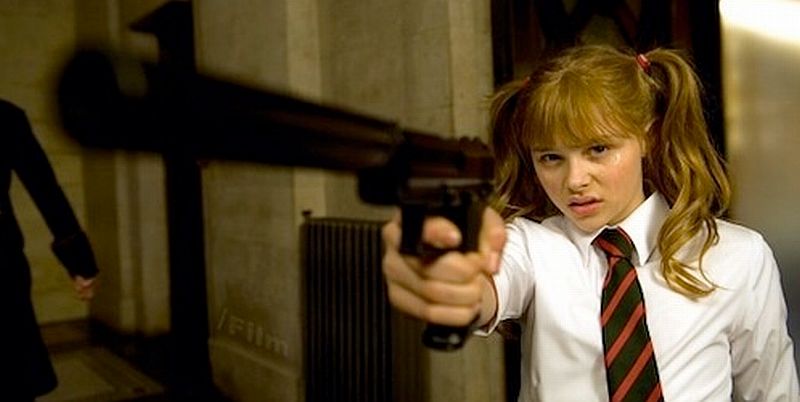
I’ve noticed a clear trend over the past couple of years for action-heroines to skew younger. Both of the principal 2011 genre entries to date, Sucker Punch and Hanna have featured heroines who aren’t old enough to drink, particularly in the latter’s case. One of the most anticipated films, currently in pre-production, is The Hunger Games, in which a 16-year old girl is press-ganged into a fight to the death, against other teenagers. But we’ve seen examples previously too, notably in last year’s Kick-Ass, where a foul-mouthed moppet stole the film in many people’s eyes, albeit not without causing a great deal of controversy.
Let’s review these, and some other entries in the sub-genre, both historical and fictional. You can find them all the way back to the seventh century, such as China’s Princess Pingyang, who was born in 598, and was instrumental in raising and leading an army of 70,000 men in a successful rebellion against the Emperor Yang, before reaching her twentieth birthday. This helped establish her father as the first Emperor of the Tang dynasty, often regarded as a high-point of Chinese civilization. We can perhaps file Mulan in this category too, though the poem does not assign her a specific age.
 Joan of Arc was perhaps the first world renowned teenage action-heroine. She led the French army at the age of 16 or 17, lifting the siege of Orleans and turning the course of the Hundred Years’ War in France’s favour, though it rumbled along for decades more. A little later in French history, Jeanne Laisné, known as Jeanne the Hatchet after a crucial role in preventing the capture of Beauvais by the Duke of Burgundy. Many countries have their own “Joans”, and sher may well have been an inspiration for Maria Rosa, a 15-year old girl who claimed divine visions and led a rebel army during the Brazilian Contestado War around 1914.
Joan of Arc was perhaps the first world renowned teenage action-heroine. She led the French army at the age of 16 or 17, lifting the siege of Orleans and turning the course of the Hundred Years’ War in France’s favour, though it rumbled along for decades more. A little later in French history, Jeanne Laisné, known as Jeanne the Hatchet after a crucial role in preventing the capture of Beauvais by the Duke of Burgundy. Many countries have their own “Joans”, and sher may well have been an inspiration for Maria Rosa, a 15-year old girl who claimed divine visions and led a rebel army during the Brazilian Contestado War around 1914.
Around the year 1660, we find the lyrically-named Görwel Christina Carlsdotter Gyllenstierna. Wikipedia tells us this Swedish noblewoman “was known by her contemporaries for her great learning as well as for her interest and skill within sports normally reserved for males.” She was referred to as “A Minerva and an Amazon in one”, and made herself widely known in her mid-teens, when she challenged a Lieutenant Colonel in the Swedish military to a duel – he had married her cousin against the consent of her family. I couldn’t find any record of the duel’s result, but she would certainly seem to qualify as an action-heroine.
A fairly notable case was that of Mary Ann Talbot (above left), who took a male name and joined the British Navy at age 14. to be with her lover. She was wounded twice and captured by the French before returning to London four years later. She only revealed her gender when a press-gang tried to re-enlist her forcibly, at age 19. She then became a servant in the household of a publisher, who subsequently published her memoirs. Another teenager to take this route around the same time, was 17-year old Anna Lühring, who fought in the Prussian Army as “Edward Kruse”, and remained with her unit even after her true identity was discovered.
 Such tactics were necessary in Western society because of the increasing belief that women were not “fit” for combat. It was still possible as late as 1915, when Dorothy Lawrence (right) posed as a man to reach the Somme front-lines, where she laid mines, until illness forced her to reveal her identity. Her memoirs are available, free, from Google E-books. Finally, a couple of others about whom not much is known. Candelaria Figuerdo joined the Cuban revolutionary forces in 1868 at 16, and is said to be the first woman to fight in defense of Cuba. And Rayna Kasabova was a Bulgarian air force pilot and the first woman in the world to participate in a military flight. At 15, during the First Balkan War in 1912, she flew above Edirne to throw out propaganda leaflets in Turkish.
Such tactics were necessary in Western society because of the increasing belief that women were not “fit” for combat. It was still possible as late as 1915, when Dorothy Lawrence (right) posed as a man to reach the Somme front-lines, where she laid mines, until illness forced her to reveal her identity. Her memoirs are available, free, from Google E-books. Finally, a couple of others about whom not much is known. Candelaria Figuerdo joined the Cuban revolutionary forces in 1868 at 16, and is said to be the first woman to fight in defense of Cuba. And Rayna Kasabova was a Bulgarian air force pilot and the first woman in the world to participate in a military flight. At 15, during the First Balkan War in 1912, she flew above Edirne to throw out propaganda leaflets in Turkish.
The purpose of all this is to show that age, or lack thereof, is no impermeable barrier. Even when barely into the teenage years, and certainly too young to vote or drink, women are capable of courage and action. But it has long been a problematic in the movie world. While I wouldn’t claim it was the first of the genre, undeniably the most influential was Luc Besson’s Léon, a.k.a. The Professional. In this Natalie Portman played Matilda, a 12-year old who sees her whole family gunned down by a corrupt DEA squad, but has the good fortune to live next door to a taciturn assassin (Jean Reno) who takes her in – not without qualms on his part. She wants to become a ‘cleaner’, like him, so she can avenge her family, and launches a one-girl assault on the DEA headquarters. That triggers their head, the supremely-psychotic Gary Oldman, to marshal forces of his own, setting the scene for a truly memorable final battle.
It’s one of my all-time favorites, but a number of critics found the relationship between Matilda and Léon troublesome, such as Gene Siskel calling it “questionable in its would-be sexy portrayal of a pre-teenage girl.” Part of the problem is it is Matilda who tries to instigate a physical relationship, pouncing on the first thing anywhere approaching genuine affection that she has ever experienced – Léon isn’t much more emotionally-rounded, and has no idea how to respond, except for a vague feeling it’s not right. But it is, apparently, okay to train Matilda as an apprentice killer. These aspects were a lot more explored in the extended European version, which runs 25 minutes longer; the US version was edited after test audiences reacted badly to Matilda’s more adult activities.
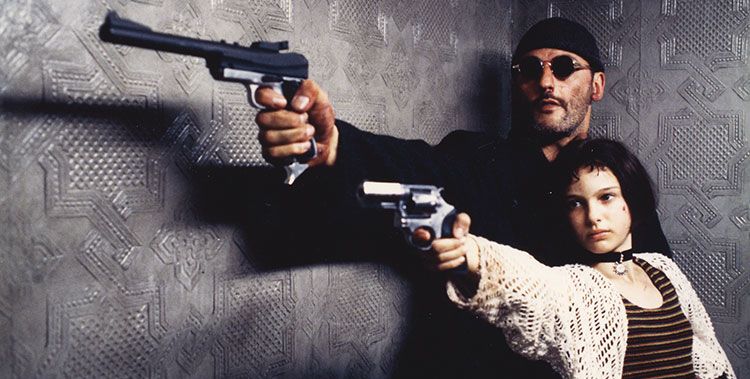
One can look to Japan for other provocative examples, both live-action and animated. The origins go back well before that, however, to the sixties and the pinky violence genre, which combine sex and…well, violence. While not all such “bad girl” films necessarily involve teenagers, some would certainly qualify, such as the marvellously-titled Terrifying Girls’ High School: Lynch Law Classroom, which lobs horror elements into the mix. I hope to cover more from this genre in the coming year. But teenage terrors extend beyond this: others worth mentioning with characters who can kill you as easily as they’d go shopping include Azumi, The Machine Girl and Mutant Girls Squad. These all represent an interesting counterpoint to the rigid role models typically imposed on women in Japanese society, and their popularity may represent a rebellion of sorts against this.
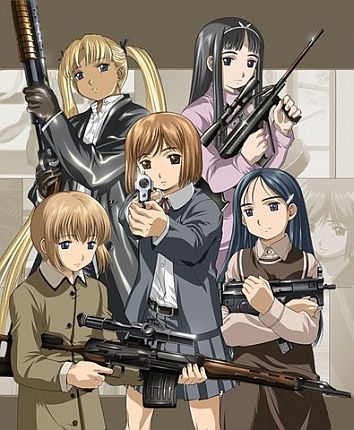 In a somewhat more light-hearted vein (for the most part), many anime and manga series have had teenage protagonists – as you’d expect, given they are often the core audience. The archetype goes back at least to the mid-1950’s, and Osama Tezuka’s Princess Knight, about a princess who must pretend to be male, so she can inherit the throne. There are too many of these even to list here, but some of the most well-known action-oriented examples in the West include Project A-ko, Sailor Moon, Blood: The Last Vampire, Cutie Honey, Gunslinger Girl (left), Noir and Dirty Pair – particularly Dirty Pair Flash, where both Kei and Yuri are seventeen-year olds.
In a somewhat more light-hearted vein (for the most part), many anime and manga series have had teenage protagonists – as you’d expect, given they are often the core audience. The archetype goes back at least to the mid-1950’s, and Osama Tezuka’s Princess Knight, about a princess who must pretend to be male, so she can inherit the throne. There are too many of these even to list here, but some of the most well-known action-oriented examples in the West include Project A-ko, Sailor Moon, Blood: The Last Vampire, Cutie Honey, Gunslinger Girl (left), Noir and Dirty Pair – particularly Dirty Pair Flash, where both Kei and Yuri are seventeen-year olds.
Probably the most notorious example of live-action is Battle Royale, which follows a class of 15-year olds as they are kidnapped by the goverment, put on a deserted island and ordered to kill each other, in order to strike fear into the rest of the nation’s youths. The results show that lethal intent is by no means limited to the male sex, and the film was condemned at the time of its release in late 2000, by some in the Japanese parliament as “crude and tasteless”, who also complained about the ‘R15’ rating, saying it was liable to harm teenagers. Rumour has it that it has been “banned” in the United States, but it’s more that the makers were concerned about possible US lawsuits, post-Columbine. The movie may eventually come out – in its 10th-anniversary, 3D version!- this year.
The movie is unquestionably an influence on The Hunger Games, a young-adult novel written by Suzanne Collins, now in the process of being made into a major film. In both the setting is sometime in the future, when the threat of chaos has forced the totalitarian government into tough measures: randomly selecting children to participate in a “kill or be killed” contest, televised nationally “pour discourager les autres”, as Voltaire almost once said. Collins has never acknowledged the similarities, and it’s possible she was unaware of underground cinema – but it’s hard to believe everyone who saw the manuscript was similarly ignorant.
My major concern is whether the film will be able to pack the wallop contained in some of the book’s sequences, while working within the PG-13 rating it’s aiming for. [I note the irony of the rating system: there’s nothing to stop teenagers from buying the books which describe, in bloody details, murder of and by children. But see those same fictional events acted out in a cinema? Not without an accompanying parent or guardian] One suspects the result will, inevitably, be watered-down: it will take some skill from director Gary Ross, to replace the visceral impact with a more emotional one. It’s certainly not the Twilight saga, which has sharply divided readers. Bella is too ’emo’ for many tastes, but the supporting characters provide some counterpoints to that argument. If you’re looking for strong female roles in that genre, forum contributor Yâoguài provided a useful introduction to some other entries worth a look.
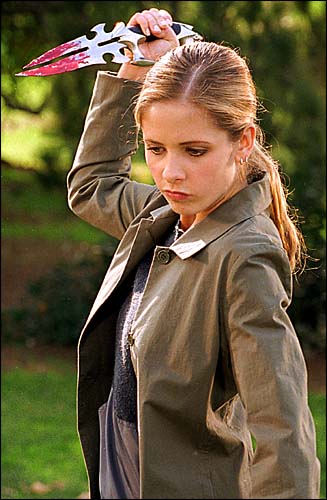 Quick: name a film where Saoirse Ronan plays a teenage assassin – besides Hanna. She seems to have developed a taste for the genre, as she also plays one in Violet & Daisy, directed by Geoffrey Fletcher (the screenwriter for Oscar-winner Precious). She is Daisy, along with Alexis Bledel as Violet: the two young killers for hire accept what they think will be a quick-and-easy job, until an unexpected target throws them off their plan. Said Ronan, “They couldn’t be more different [from Hanna]. Daisy is a really, really sweet girl. She’s not a natural killer like Violet is… They have their own little world. And everything is poppy and fun and about puppy dogs and dresses. They’re taking on this job because they want to get this dress that their pop idol has. Her name is Barbie Sunday.”
Quick: name a film where Saoirse Ronan plays a teenage assassin – besides Hanna. She seems to have developed a taste for the genre, as she also plays one in Violet & Daisy, directed by Geoffrey Fletcher (the screenwriter for Oscar-winner Precious). She is Daisy, along with Alexis Bledel as Violet: the two young killers for hire accept what they think will be a quick-and-easy job, until an unexpected target throws them off their plan. Said Ronan, “They couldn’t be more different [from Hanna]. Daisy is a really, really sweet girl. She’s not a natural killer like Violet is… They have their own little world. And everything is poppy and fun and about puppy dogs and dresses. They’re taking on this job because they want to get this dress that their pop idol has. Her name is Barbie Sunday.”
On television, one show stands out above all others: Buffy the Vampire Slayer, which followed the life of Buffy Summers, through the discovery of her powers and on through college and into adulthood. But the first three seasons of the series (as well as the feature which preceded it) all took place at High School, and it’s there that the show’s foundations were laid – and some would argue, its best work done (certainly, the show received its best ratings). The influence of Buffy on the field has been enormous, with a slew of shows which owe a debt to her in one form or another, and it’s no exaggeration to say that the heroine became a cultural icon. Indeed, it found a success, both critical and commercial, which those involved have found somewhat hard to recapture. Joss Whedon’s subsequent forays into TV, in Dollhouse and Firefly, both were canceled due to low ratings, though the former has its own devoted cult following.
Even the most contentious of the above, however, were a mere blip compared to the – and there’s not really another word – shitstorm that greeted Kick-Ass last year, mostly for its tiny killing machine, Hit Girl (Chloe Moretz). The relationship is similar to that in Leon, except that it’s her father (Nicolas Cage) who is her tutor. And, while Matilda never actually kills anyone, Hit Girl does so with gleeful, foul-mouthed abandon. “Okay, you cunts – let’s see what you can do now,” she says, before taking apart an apartment full of drug-dealers and low-lives. When it comes to the action, she’s certainly a great deal more competent and confident than the hero.
But not everyone was impressed…
“Millions are being spent to persuade you that Kick-Ass is harmless, comic-book entertainment suitable for 15-year-olds. Don’t let them fool you… It deliberately sells a perniciously sexualised view of children and glorifies violence, especially knife and gun crime, in a way that makes it one of the most deeply cynical, shamelessly irresponsible films ever… The reason the movie is sick, as well as thick, is that it breaks one of the last cinematic taboos by making the most violent, foul-mouthed and sexually aggressive character, Hit-Girl, an 11-year-old.The movie’s writers want us to see Hit-Girl not only as cool, but also sexy, like an even younger version of the baby- faced Oriental assassin in Tarantino’s Kill Bill 1. Paedophiles are going to adore her. One of the film’s creepiest aspects is that she’s made to look as seductive as possible… She’s fetishised in precisely the same way as Angelina Jolie in the Lara Croft movies, and Halle Berry in Catwoman. As if that isn’t exploitative enough, she’s also shown in a classic schoolgirl pose, in a short plaid-skirt with her hair in bunches, but carrying a big gun. Kick-Ass is not the harmless fun it pretends to be. Yes, it’s lightweight and silly, but it’s also cynical, premeditated and mindbogglingly irresponsible. And in Hit-Girl, the film-makers have created one of the most disturbing icons and damaging role-models in the history of cinema.”
Even for the most reactionary critic on the most reactionary newspaper (The Daily Mail) in the UK, that’s harsh – and largely unjustified. There’s very little sexual about Hit Girl at all; the hero has absolutely no interest in her (being keener on a girl who thinks he’s gay!), and she’s almost entirely no-nonsense and practical. The only possible exception is the scene where she dresses in the schoolgirl uniform shown atop this piece to get into the villains’ headquarters, and that’s exploiting the vulnerability of the image than its sexuality. But guess which pic, of all the dozens possible from the movie, is used to illustrate the review on Tookey’s own website? Yep. The same. He’s happy to condemn, while simultaneously exploiting it for his own moral agenda.
 But his reading of the movie says a lot more about the writer than the film: as another critic mentioned, “If anyone finds her sexy. it’s because they find little kids sexy”. And the truth finally came out, as Tookey admitted (in the unrepentant review linked above) to having “experienced at first hand the attentions of three different men who would now be called paedophiles.” Three? As Oscar Wilde nearly put it, “To be molested once may be regarded as a misfortune; three times looks like carelessness.” It’s a known fact paedophiles were usually themselves abused as children, so I have absolutely no problem in calling Tookey out for expressing his tendencies in this area: put bluntly, I’d not leave my kids alone with him. And he was somehow surprised by the backlash?
But his reading of the movie says a lot more about the writer than the film: as another critic mentioned, “If anyone finds her sexy. it’s because they find little kids sexy”. And the truth finally came out, as Tookey admitted (in the unrepentant review linked above) to having “experienced at first hand the attentions of three different men who would now be called paedophiles.” Three? As Oscar Wilde nearly put it, “To be molested once may be regarded as a misfortune; three times looks like carelessness.” It’s a known fact paedophiles were usually themselves abused as children, so I have absolutely no problem in calling Tookey out for expressing his tendencies in this area: put bluntly, I’d not leave my kids alone with him. And he was somehow surprised by the backlash?
This is by no means an exhaustive survey. I could have gone on at quite some more length. Hanna. True Grit. Let the Right One In. But it does reflect, to some extent, the way society views teenage action heroines, because they are even more transgressive that adult action heroines. Women aren’t “supposed” to be assertive, self-confident or prepared to battle, physically, for what they believe. The same is true for children. Combine the two and – despite the examples drawn from history given above – you’ve got something which pushes a lot of society’s buttons. And I suspect that’s not something which is likely to change anytime soon.
See also:
- 13 Frightened Girls!
- Abigail (2019)
- The Accidental Keyhand, by Jen Swann Downey
- After the Pandemic
- Angelbound, by Christina Bauer
- The Archer
- Assassinaut
- Azumi
- Baby Assassins
- Barely Lethal
- Becky
- The Blind Spot, by Michael Robertson
- Blood +: Episodes 1-25
- Blood: The Last Vampire (animated)
- Blood: The Last Vampire (live-action)
- Bloodbath at Pinky High, Part 1
- Bloodbath at Pinky High, Part 2
- Bloody Chainsaw Girl
- Book of Monsters
- The Breadwinner
- Buffy the Vampire Slayer (film)
- Buffy the Vampire Slayer: season two
- Buffy the Vampire Slayer: season six
- Buffy the Vampire Slayer: season seven
- Cattle Annie and Little Britches
- Chastity Bites
- The Circle (Cirkeln)
- Cold November
- Counterfeiting in Suburbia
- Crimson, by Arthur Slade
- The Darkest Dawn
- Darkness on the Edge of Town
- Deidra and Laney Rob a Train
- The Dirty Pair
- E.M.P. 333 Days
- The Eagle Huntress
- Eko Eko Azarak
- Enola Holmes
- Enola Holmes 2
- Fair Game (1982)
- The Feral Sentence by G. C. Julien
- Final Girl
- Fugitive at 17
- Girl of Fire, by Norma Hinkens
- Go For Broke
- Grand Theft Auto Girls
- Grave Mercy, by Robin LaFevers
- Gunslinger Girl
- Hanna
- Hell’s Fury: Wanted Dead or Alive
- High School Girl Rika: Zombie Hunter
- High School Hellcats
- Homestead
- How I Live Now
- The Hunger Games (film)
- The Hunger Games: Catching Fire
- The Hunger Games: Mockingjay – Part 1
- The Hunger Games: Mockingjay – Part 2
- Hunter, Warrior, Commander by Andrew Maclure
- The incredible, true survival story of Juliane Koepcke
- Into the Dark, by J.A. Sutherland
- Joan of Arc: History vs. Cinema
- Justice High
- Kill Craft
- Kill La Kill
- Killer K
- Kim Possible
- Kite
- Kite (live action)
- Kitty the Killer
- Kyoko vs. Yuki
- The Last Dragonslayer
- The Last Survivors
- Lethal Dispatch, by Max Tomlinson
- Locked Up
- Maidentrip
- Miracles Still Happen
- Molly
- Mutant Girls Squad
- My Day
- Nausicaä of the Valley of the Wind
- Nightblade: A Book of Underrealm by Garrett Robinson
- No Safe Haven, by Kyla Stone
- The Poppy War, by R.F. Kuang
- De Prooi
- Prospect
- Resilience and the Lost Gems
- A Resistance
- Riddle Story of Devil
- Ride Hard: Live Free
- Rina Takeda: The Next Action Heroine?
- Riot Girls
- Run Hide Fight
- RWBY
- Sailor Suit and Machine Gun
- Sailor Suit and Machine Gun: Graduation
- Sexy Battle Girls
- Shadow Corps, by Justin Sloan
- Sket
- Sucker Punch
- Sugar & Spice
- The Sun At Midnight
- Switchblade Sisters
- Teenage Bank Heist
- Teenage Hooker Becomes a Killing Machine
- Tokyo Ballistic War
- The Tribe
- True Grit
- Vesper
- Violet and Daisy
- Viral
- War Witch
- Warchild: Pawn, by Ernie Lindsey
- Wendy Wu: Homecoming Warrior
- Wicked Blood
- Wilderness Survival for Girls
- Winter’s Bone
- The Witch Files
- The Witch: Part 1. The Subversion
- The Wrath of Becky
- Yasmine
Mother’s Day (2010)
★★★★
“Hell hath no fury like a mother.”

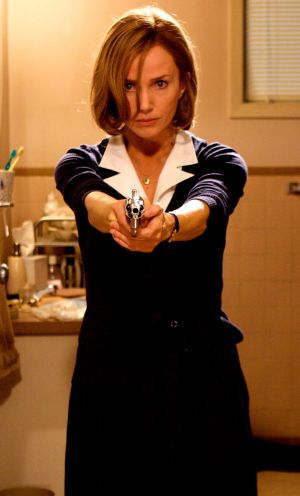 A loose remake of a somewhat infamous 1980 horror movie [rejected by the BBFC and as yet unreleased in the UK], this is a nastily brutal and effective home-invasion story, with a maternal angle that’s both surprising and well done. On the run after a botched bank robbery, the three Koffin brothers end up in the wrong home, and end up with a houseful of hostages, who were visiting Beth Sohapi (King) and her husband. The criminals call on the rest of their family for help, led by their mother (De Mornay), who is 50% June Cleaver – even providing cake and ice-cream for the residents – and 50% Lizzie Borden, showing absolutely no restraint against anyone she perceives as threatening her brood. As the night progresses, a lot of skeletons come out and we discover the Sohapis definitely do not live up to their name…
A loose remake of a somewhat infamous 1980 horror movie [rejected by the BBFC and as yet unreleased in the UK], this is a nastily brutal and effective home-invasion story, with a maternal angle that’s both surprising and well done. On the run after a botched bank robbery, the three Koffin brothers end up in the wrong home, and end up with a houseful of hostages, who were visiting Beth Sohapi (King) and her husband. The criminals call on the rest of their family for help, led by their mother (De Mornay), who is 50% June Cleaver – even providing cake and ice-cream for the residents – and 50% Lizzie Borden, showing absolutely no restraint against anyone she perceives as threatening her brood. As the night progresses, a lot of skeletons come out and we discover the Sohapis definitely do not live up to their name…
What looks initially like another variant on the Last House on the Left takes an abrupt left-turn when Mrs. Koffin shows up. From there on, De Mornay holds the viewer’s attention with an effortless performance which makes you wonder where she has been for the last 20 years. There are certainly echoes of her character from The Hand That Rocks The Cradle, but I’m also reminded, in tone, of Kathleen Turner in Serial Mom. What I think is particularly disturbing is her rapid switch from homespun family wisdom to violence of a particularly cruel sort – and not just physical, but mental, as she is generally astute when it comes to pushing her victim’s buttons. I say “generally,” for Beth provides an opponent that even Mrs. Koffin can’t necessarily read accurately. It’s clear, almost from the start, that this will be heading towards a confrontation between the two.
At 112 minutes, it could seem long, but I can’t say my attention flagged at any point. If there is a criticism, it’s the not uncommon one for the genre, of characters who have to exhibit “stupidity necessary to the plot.” There were certainly points at which Chris rolled her eyes as the victims did not behave in the way she would have; I tend to find how much that impacts my appreciation depends on how blatant that is, and how much I’m enjoying the other aspects of the film. Here, watching De Mornay is so entertaining – I’m hard pushed to think of many comparable, deliciously villainous performances from an actress – that I’m happy to overlook those flaws. I’ve seen and enjoyed other home invasion films, like The Strangers; this takes a very different approach, replacing those faceless monsters with a twisted version of humanity. In some ways, it may be even more effective.
Dir: Darren Lynn Bousman
Star: Rebecca De Mornay, Jaime King, Briana Evigan, Patrick Flueger
Gang of Roses II: Next Generation
★½
“Why? No, really: why?”
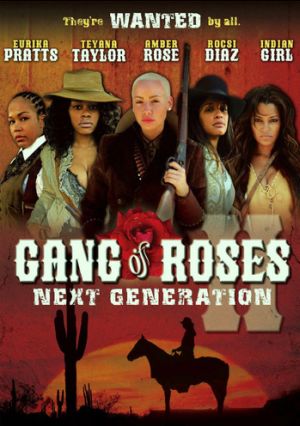 There are films which get a sequel because they’re successful. There are films which get a sequel because they are good. And then there’s a sequel to a film which was sub-mediocre, and appeared to vanish without causing even a ripple after its straight to video release in 2003. As a measure, nine years later, it hasn’t even reached 750 votes on the IMDB. Yet, we get this: a sequel that is neither needed, nor demanded by the public, and which manages to be even more boring and badly-constructed than its predecessor. Most movie-makers acquire at least a measure of technical skill as their career progresses, bur La Marre seems to have forgotten what little he knew a decade ago.
There are films which get a sequel because they’re successful. There are films which get a sequel because they are good. And then there’s a sequel to a film which was sub-mediocre, and appeared to vanish without causing even a ripple after its straight to video release in 2003. As a measure, nine years later, it hasn’t even reached 750 votes on the IMDB. Yet, we get this: a sequel that is neither needed, nor demanded by the public, and which manages to be even more boring and badly-constructed than its predecessor. Most movie-makers acquire at least a measure of technical skill as their career progresses, bur La Marre seems to have forgotten what little he knew a decade ago.
La Marre and Lamont Clayton are the only returning names from the original here – there’s a claim that Cassie is an member of the gang of female outlaws there, but neither actress Charli Baltimore nor her character seem to have been in it. She’s sitting in jail with the combination to a military safe, and for some reason, divulges the plan to break the safe to her cellmate Collette (Pratts), about two minutes after they’re introduced. Cassie is killed during an escape attempt, but Collette, with her knowledge, slides in to the gang, who then sit around a hotel room for what feels like ever. Eventually, they head to the town of San Juevo, and prepare for action, not knowing they are being stalked by Lee (Casseus) and his gang, out for revenge on the women. Yes, even though they are completely different ones from the first film. That’s the level of coherence you can expect from this.
Somewhat of a troubled production, apparently, with Taylor and La Marra getting into a brawl on set. Sure that improved the creative atmosphere immeasurably. But even the cheapest publicity stunt couldn’t have saved this wretched mess, which has exactly two decent scenes: one with one of the Roses speaking to the pastor of the San Juevo church, and another interacting with a little girl. That’s it. The action is horribly staged – the film budget couldn’t even run to fake blood, it seems – and it’s a merciful release that the film runs 15 minutes less than I was braced for. The balance is made up with La Marre’s entry to the 2012 World’s Least Amusing Out-takes competition. It’s a sure winner there: the only possible award for which this possesses any chance.
Dir: Jean-Claude La Marre
Star: Teyana Taylor, Eurika Pratts, Claudia Jordan, Gabriel Casseus
Brave
 ★★★
★★★
“Brave, but too much heart?”
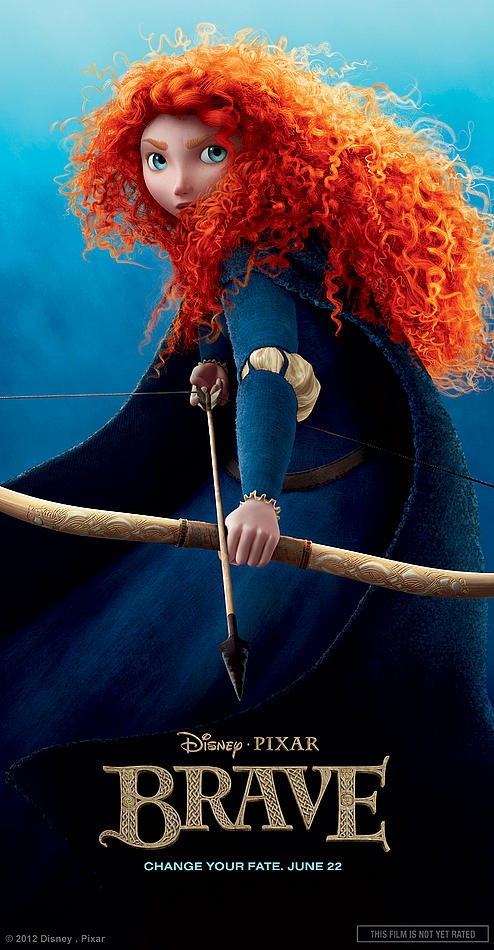 I was immensely stoked for Brave on a number of levels. First, Pixar kicks ass. With the exception of the underwhelming Cars and its pointless sequel, the quality of their work speaks for itself: Monsters, Inc is close to the finest animated movie of all time. Secondly, genuine action heroine films for the whole family are rare, to the point that they can probably be counted on the fingers of one hand over the past 25 years. Thirdly, it’s Scotland. Y’know, where I’m from. It’s the bit at the top of England. I feel I should mention this, because Pixar had originally tabbed Reese Witherspoon to voice the teenage, Scottish heroine, Merida. Fortunately, scheduling prevented this, and Pixar ended up with an all-Scottish lead cast.
I was immensely stoked for Brave on a number of levels. First, Pixar kicks ass. With the exception of the underwhelming Cars and its pointless sequel, the quality of their work speaks for itself: Monsters, Inc is close to the finest animated movie of all time. Secondly, genuine action heroine films for the whole family are rare, to the point that they can probably be counted on the fingers of one hand over the past 25 years. Thirdly, it’s Scotland. Y’know, where I’m from. It’s the bit at the top of England. I feel I should mention this, because Pixar had originally tabbed Reese Witherspoon to voice the teenage, Scottish heroine, Merida. Fortunately, scheduling prevented this, and Pixar ended up with an all-Scottish lead cast.
I also note the somewhat troubled production: despite two names getting directorial credit, this wasn’t a co-direction. Mark Andrews replacing Brenda Chapman as a result of what Chapman called “creative differences.” This was certainly an embarrassment to Pixar, who had long been criticized for their very male-dominated output, and had made a big fuss about Brave, not just featuring a female heroine, but also written and directed by a woman. The problem, according to Andrews, was that the story was unfocused. He said, “Whose story it was – whether it was Merida or her mom’s story or Merida choosing which parent she was going to be more like – these things weren’t working.” Chapman was unimpressed, telling the NY Times, “To have it taken away and given to someone else, and a man at that, was truly distressing on so many levels.”
Does this impact the final movie? It’s hard to see how it couldn’t, either through a compromise of the original vision, or as a result of the realization, mid-way through production, that it wasn’t working. Not that it’s alone – many Pixar movies have had bumpy journeys to the screen. But in this case, the end result was greeted with muted box-office success. It seems odd to describe a movie that grossed $235 million as a disappointment, but Brave showed a lot less “legs” than most Pixar films. Almost all have gathered total US box-office receipts four times or better than their opening “wide” weekend. Brave’s multiplier, of 3.56, is ahead of only the woeful Cars 2 (2.89) in studio history.
Not to say it’s bad, because it certainly isn’t. Pixar have an absolute and complete handle on the technical aspects: even in 2D, this is the best-animated (if not necessarily the “best animated”) film of 2012. The landscapes are lush to the point of seeming photographic, the characters are richly-detailed, down to the last red-haired ringlet on Merida’s head, and in motion, you remember why Pixar is #1. And there are plenty of moments where everything comes together. Witness the sequence below, depicting a contest between three suitors to win the hand of Merica. It is filled with 100% pure awesome, climaxing with the heroine’s declaration, “I am Merida, and I’ll be shooting for my own hand,” before she literally bursts out of the confines of princessly expectations.
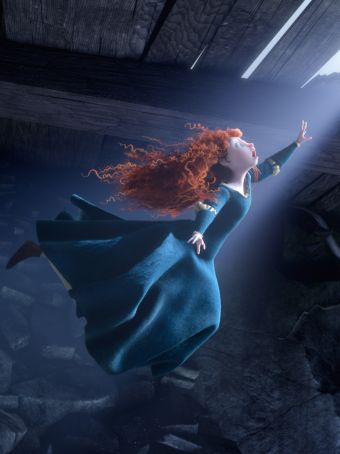 The problems are more with plotting – basically, the issue described above by Chapman is still present. The story starts in one direction, looking suitably action-oriented. It’s difficult to provide any specifics without giving spoilers – there’s a major plot-point not even hinted at in the trailers, which certainly surprised me. But I can see that it abruptly changes direction in the middle, going in a much less satisfactory direction, that seems almost to push Merida into the background of her own story. Even the climax relies less on any innate abilities of our heroine, such as her much-touted archery, or even her temperament, more the fortuitous toppling of a large geological entity [I doubt the film would have sold quite as well had it been named “Lucky”].
The problems are more with plotting – basically, the issue described above by Chapman is still present. The story starts in one direction, looking suitably action-oriented. It’s difficult to provide any specifics without giving spoilers – there’s a major plot-point not even hinted at in the trailers, which certainly surprised me. But I can see that it abruptly changes direction in the middle, going in a much less satisfactory direction, that seems almost to push Merida into the background of her own story. Even the climax relies less on any innate abilities of our heroine, such as her much-touted archery, or even her temperament, more the fortuitous toppling of a large geological entity [I doubt the film would have sold quite as well had it been named “Lucky”].
This conclusion is set up by the sort of happy compromise that is only deemed acceptable by both sides in fairy stories – anyone who has had a teenage daughter can vouch for this. I also have some qualms about the arranged marriage subplot that drives the first half of the film, which is depicted as little more than a “You’re going to do your homework, young lady, whether you like it or not” kind of way, which seems facile and dubious, even for a Disney-produced cartoon. And the introduction of “magic”, for the first time in a Pixar film, allows for the sort of convenient story developments that does nothing but weaken the overall structure. It’s not even a magical universe, instead, it’s more or less a one-shot deal, necessary to the plot.
It does fairly well in avoiding the Scottish clichés: one haggis joke, a random act of indecent exposure, and a soundtrack which oozes wannabe tartan are about it. The lack of any romantic love interest for the heroine is delightfully refreshing, and the lead actors all do a very, very good job in their roles, bringing their characters to life beautifully, to a degree that you can’t imagine any other voices coming out of their mouths. [I repeat: Reese Witherspoon?] It’s not boring. but fails to engross in the way that the better Pixar movies invariably succeed in doing. I got to the end entertained, but without any real sense of investment in Merida or her fate. Put bluntly: I just didn’t care about her, and the film succeeded mostly as a commercial for the Scottish Tourist Board. As a dramatic entity on its own merits, this falls somewhere between Brother Bear and Freaky Friday.
Dir: Mark Andrews + Brenda Chapman
Star (voice): Kelly Macdonald, Emma Thompson, Billy Connolly, Julie Walters
Yakuza Hunters: Revenge Duel In Hell
★★½
“The Good, The Bad And The Hardly Ugly.”
 If its predecessor (reviewed here as Sukeban Hunters) echoed the tropes of pinky violence, this one seems to have much more in common with Sergio Leone’s spaghetti Westerns. A mysterious stranger with a dark past rides into town, only to find that the violence they sought to escape has no intention of leaving them alone, and they must once again put on their weapons to fight for…something or other. Here, it’s returning Yakuza hunter Asami (as before, conveniently played by…Asami), who comes back to visit her old master, now a bar-owner, Inokuma (Kato), who arranges for her to stay with Miki (Yoshiyuki), who used to be a bit of a Yakuza hunter in her younger days. But all is not well, for the evil Shoryu clan are intent on turfing everyone out so they can build a casino. When that turns out to include both Inokuma and Miki, with extreme prejudice, Asami must take on both their minions and the hired uber-killer Akira (Miwa), who proves she is more than a match for most.
If its predecessor (reviewed here as Sukeban Hunters) echoed the tropes of pinky violence, this one seems to have much more in common with Sergio Leone’s spaghetti Westerns. A mysterious stranger with a dark past rides into town, only to find that the violence they sought to escape has no intention of leaving them alone, and they must once again put on their weapons to fight for…something or other. Here, it’s returning Yakuza hunter Asami (as before, conveniently played by…Asami), who comes back to visit her old master, now a bar-owner, Inokuma (Kato), who arranges for her to stay with Miki (Yoshiyuki), who used to be a bit of a Yakuza hunter in her younger days. But all is not well, for the evil Shoryu clan are intent on turfing everyone out so they can build a casino. When that turns out to include both Inokuma and Miki, with extreme prejudice, Asami must take on both their minions and the hired uber-killer Akira (Miwa), who proves she is more than a match for most.
It certainly hits the ground running, the Shoryu members wielding a chainsaw in a deeply brutal fashion on both male and female victims, but overall, it’s just a tad less worthy than the original – there were times, particularly with regard to the audio, when the cheapness just seemed too much to handle. On the plus side, most of the gore effects are practical, rather than CGI, which was a welcome surprise after watching several genre entries from the Sushi Typhoon stable, and the action sequences are occasionally surprisingly impressive, most notably when Asami battles two Shoryu henchmen, in what’s effective a single take for each fight. However, the final battle – which, it’s no spoiler to say, is between Asami and Akira – is a disappointment, with flaky CGI and a really dubious conclusion.
Supposedly set three years after part one, I’d guess it was more or less filmed back-to-back, though there’s enough continuity issues to make me steer clear of calling this a “sequel” – not least, Asami possessing several more fingers than she should. I can see what the makers were aiming for [not least the soundtrack, which shamelessly adopts the spirit of Ennio Morricone], but they’ve picked a much harder target this time. They don’t have the necessary ability to pull it off, and the results don’t make up for the shortfall in skill with adequate energy.
Dir: Shinichi Okuda
Star: Asami, Yumi Yoshiyuki, Sakichi Kato, Hitomi Miwa
Hannah’s Law
★★★
“A straightforward tale of revenge, Western style.”
 In 1866, the young child Hannah Beaumont (Canning, best known for her role in The Vampire Diaries) watches as the rest of her family is slaughtered by outlaw Frank McMurphy (Pyper-Ferguson). Twelve years later, Hannah is now getting her long-awaited revenge. Having been trained to shoot, ride and collect the bounty on wanted men by Isom Dart (Danny Glover in a small role), she is now reeling in the members of McMurphy’s gang, one by one. When McMurphy hears about this, he gathers up his entire posse and rides to Hannah’s base in Dodge City to finish off what he started, a decade before. Can Hannah – with the aid of the town’s deputy marshal, Wyatt Earp (Holt) and her other friends, come out on top?
In 1866, the young child Hannah Beaumont (Canning, best known for her role in The Vampire Diaries) watches as the rest of her family is slaughtered by outlaw Frank McMurphy (Pyper-Ferguson). Twelve years later, Hannah is now getting her long-awaited revenge. Having been trained to shoot, ride and collect the bounty on wanted men by Isom Dart (Danny Glover in a small role), she is now reeling in the members of McMurphy’s gang, one by one. When McMurphy hears about this, he gathers up his entire posse and rides to Hannah’s base in Dodge City to finish off what he started, a decade before. Can Hannah – with the aid of the town’s deputy marshal, Wyatt Earp (Holt) and her other friends, come out on top?
Well, there’s really not much doubt about that, this being a Hallmark Original Movie. Which means, as well as good winning out, there will be no sex or bad language, and severely restraint is exercised on the violence front. That said, knowing this going in will help defuse much sense of anticipation, and if you can get past the feeling this belongs to a far kinder, gentler age of cinema, it’s not a bad time-passer. Canning doesn’t quite look the part, being too willowy to be convincing, but that really only attracts the attention during the occasional hand-to-hand scene – firearms are a great equalizer for size and strength. She does manage to exude the required amount of steely determination, which is likely more important for this role.
Director Talalay’s name may be familiar to GWG fans; she directed the flop Tank Girl back in 1995. From the IMDB list, this looks to be her first return to the action heroine field since, and she has her moments, not least the first encounter between McMurphy’s gang and the very alone Hannah in Dodge City. Credit also to Kennedy, who plays Doc Holliday by shamelessly channeling Val Kilmer from Tombstone, yet still comes across as a memorable character. However, the presence of both Glover and Kimberly Elise as black gunslinger Stagecoach Mary, imply a racial blindness to the era that one suspects is more based on modern hopes than historical accuracy. Still, while the net result is not particularly memorable, and is clearly more interested in fulfilling expectations than confounding them, it succeeds in reaching its modest goals, in a way that some previous entries in the genre could only envy.
Dir: Rachel Talalay
Star: Sara Canning, Greyston Holt, John Pyper-Ferguson, Ryan Kennedy
The Hike
★★
“The Descent without the caves. Or monsters.”
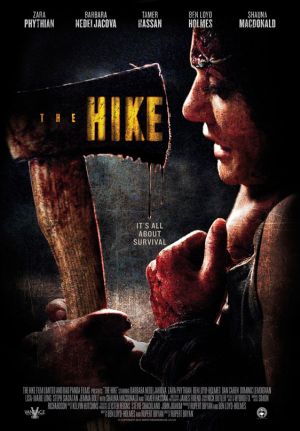 Five young women head out into the country for a camping trip, led by Kate (Phythian), a former soldier who is stil traumatized by seeing her boyfriend killed in front of her while on a mission in the Middle East. She’s about the only member of the party who seems genuinely keen on the trip, and it’s not long before the others start to whine, demanding rest stops, and the hike is curtailed before the intended destination. At least the country is not entirely deserted, though the creepy East European guy and his two women isn’t exactly sociable. But at least there are the three nice guys, out for a spot of rock-climbing, led by Ethan (Loyd Holmes), so there’s always that. And if things end up getting dicey – say, if one of the women vanishes mysteriously, while out gathering firewood, the others can turn to Ethan and his chums for help. Right? Right?
Five young women head out into the country for a camping trip, led by Kate (Phythian), a former soldier who is stil traumatized by seeing her boyfriend killed in front of her while on a mission in the Middle East. She’s about the only member of the party who seems genuinely keen on the trip, and it’s not long before the others start to whine, demanding rest stops, and the hike is curtailed before the intended destination. At least the country is not entirely deserted, though the creepy East European guy and his two women isn’t exactly sociable. But at least there are the three nice guys, out for a spot of rock-climbing, led by Ethan (Loyd Holmes), so there’s always that. And if things end up getting dicey – say, if one of the women vanishes mysteriously, while out gathering firewood, the others can turn to Ethan and his chums for help. Right? Right?
With a bit more thought on characterization and dialogue, this could have been an effective exercise. When I say, “a bit,” I probably mean “an awful lot,” as apart from Kate, the women are at best flat and two-dimensional, and at worst, actively and significantly irritating. Do women really act and sound like that? It may be relevant the script was written by two men, and there are few surprises to be found here (especially if you’ve seen Eden Lake, a similarly-themed “rural nightmare” flick from the UK). The progression is so obvious that it doesn’t even count as a spoiler to reveal that Kate ends up the ‘final girl’, and it’s likely significant that the more the film focuses on her struggles for survival, the more effective it becomes, to the point where the last reel eventually delivers the tension and energy I’d hoped to see from the beginning.
It definitely does owe some inspiration to The Descent: I don’t think it’s coincidence that Shauna McDonald has a small role as Ethan’s wife. However, I also note Nedeljacova’s role in the Hostel series, which perhaps has rather more in common with this, as the movie relishes the rape and degradation elements to a greater degree than I like. Phythian does what she can with the role and comes over as a decent heroine, who goes through hell and back again over the course of 24 hours. However, there are plenty of better entries in the genre, and little otherwise to recommend this one.
Dir: Rupert Bryan
Star: Zara Phythian, Ben Loyd Holmes, Barbara Nedeljacova, Daniel Caren
Robogeisha
★★★½
“‘I, too, have an ass-sword.’ That quote about sums this up.”
 Having been largely unimpressed by Iguchi’s other work, which seemed to have little to offer except megabytes of digital blood, I likely wouldn’t have watched this except an accident involving beer and my Apple TV remote has stopped me from much of my usual viewing. I could still stream from Netflix, however, though when I saw this was dubbed in English, I almost didn’t bother. But surprisingly, this has easily the best plot of his movies, with a slyly-twisted sense of imagination that’s very effective.
Having been largely unimpressed by Iguchi’s other work, which seemed to have little to offer except megabytes of digital blood, I likely wouldn’t have watched this except an accident involving beer and my Apple TV remote has stopped me from much of my usual viewing. I could still stream from Netflix, however, though when I saw this was dubbed in English, I almost didn’t bother. But surprisingly, this has easily the best plot of his movies, with a slyly-twisted sense of imagination that’s very effective.
It centres on sisters Yoshie (Kiguchi) and Kikue (Hasebe), the latter a geisha who is cruel and vindictive to her younger sister. They are taken by Hikaru Kageno (Saito), the scion of Kageno Steel, to his castle and inducted as recruits into a geisha army, which he is using to take out opponents to his plans for national domination. Yoshie has an innate skill for assassination, soon surpassing Kikeu, who begs Hikaru to “upgrade” her mechanically, so she can best her sister. Yoshie, to keep up, is similarly enhanced.
The scenario shifts when Yoshie is sent to take out a group of senior citizens and discovers they are the families of other members of the geisha army – far from being willing volunteers, they were abducted and brainwashed by Kageno and his father. After narrowly escaping a suicide mission, Yoshie switches sides and joins the senior citizens, who add further to her artificial armoury. It’s up to her to stop Kageno, before he can drop a massive nuclear weapon into Mount Fuji, completing his plan.
This is certainly out there, but is a good deal lighter in tone than expected, often crossing the border into an outright silliness that is actually endearing. For instance the whose “castle-shaped robot” concept is beautifully ludicrous, not least as the building rampages around, whacking building that then spurt blood, for no readily apparent reason. There’s also shades of 60’s spy thrillers like Dr. Goldfoot and the Girl Bombs in the basic concept of the geisha army, though there’s still a certain ass-fetishism which I could have done without – swords and shuriken both come flying out of there.
Complaining that this is, to quote Monty Python, “too silly,” would be missing the point, and the fight sequences are well put-together, not least when involving Kageno’s lead henchwomen, the Tengu Twins. At over 100 minutes, it is likely a little too long and these are less performances, than hangers, on which to place lurid visuals of questionable taste. However, you will want to keep watching, simply to see what the heck Iguchi will come up with next.
Dir: Noboru Iguchi
Star: Aya Kiguchi, Hitomi Hasebe, Takumi Saito, Taro Shigaki
Running Delilah
★★
“Cast better than the material, in female version of Robocop.”
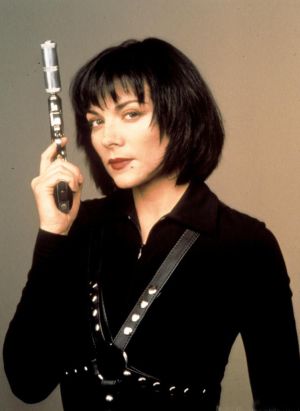 Agent Delilah (Cattrall) is undercover investigating arms dealer Alec Kasharian (Voyagis), and his connection to Palestinian terrorists [this was 1993, when people were concerned about such things]. At the behest of her handler Paul (Zane), she copies a floppy-disk containing vital information [I repeat, this was 1993, when an entire arms dealer’s business would apparently fit on a floppy!], but she’s discovered, shot multiple times, and left for dead. Paul drags her Swiss cheese-like body back to a secret government lab, where she is repaired, upgraded and generally enhanced in terms of speed, power and other abilities.
Agent Delilah (Cattrall) is undercover investigating arms dealer Alec Kasharian (Voyagis), and his connection to Palestinian terrorists [this was 1993, when people were concerned about such things]. At the behest of her handler Paul (Zane), she copies a floppy-disk containing vital information [I repeat, this was 1993, when an entire arms dealer’s business would apparently fit on a floppy!], but she’s discovered, shot multiple times, and left for dead. Paul drags her Swiss cheese-like body back to a secret government lab, where she is repaired, upgraded and generally enhanced in terms of speed, power and other abilities.
Initially, this is the subject of some emotional trauma, as she is understandably shocked to discover a Terminator arm where her own used to be. So she breaks out, roaming the streets, and proving to be a nasty surprise for sleazy low-lives. Though her creators probably need to work on the insulation thing, since her arm seems to short-circuit in the rain. That’s government work for you. Naturally, she eventually gets her act together, and the agency boss (Rigg) sends her and Paul out, to bring Kasharian to the justice he so richly deserves. This being a TV movie – or perhaps a pilot, it’s not clear – there are no prizes for guessing how this pans out.
And that’s the problem. No prizes, no surprises either, and precious little in the way of invention or inspired execution that could lift this up above the humdrum, with director Franklin (best known for Psycho II) unable to add enough impetus to proceedings. The only thing that redeems this are the decent performances from the leads, who manage to give this more impact than the material deserves – it was particularly cool to see Rigg, who played one of the prototypical action heroines. Emma Peel, in the mid-60’s. Any scenes that are memorable, such as Delilah shattering all the windows in a hotel, make absolutely no sense, and the parts that make sense, aren’t exactly memorable.
Dir: Richard Franklin
Star: Kim Cattrall, Billy Zane, Yorgo Voyagis, Diana Rigg




